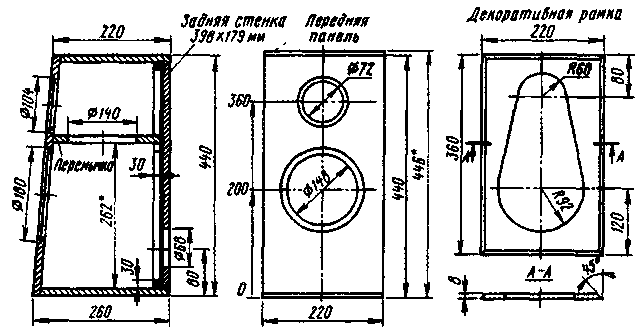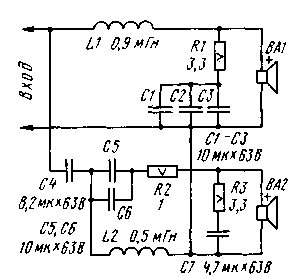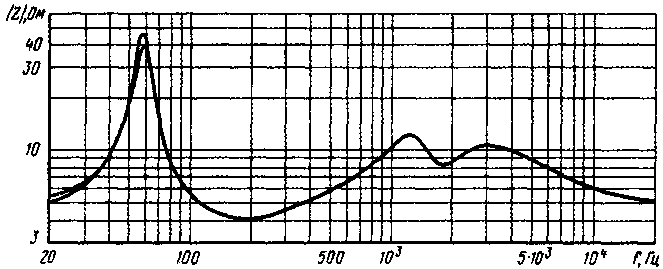To the readers made the speaker of the closed type with a useful volume of each speaker 12 L. the Choice of the closed acoustic design for bass drivers due to the fact that the speakers are on the reproduction of classical and traditional jazz music. In these genres are used acoustic musical instruments, and many music lovers believe that closed AC is better than the inverters, convey the character of the sound of such instruments in the low-frequency plot of the audio range. Besides a small speaker with a low frequency response and a modest but well-articulated bass, as the development of the system can be supplemented with high-quality bass links operating at frequencies below 100...150 Hz. Convergence of such units with closed AC is significantly more difficult than in vented enclosures. Also enclosed AC is less sensitive to variation of parameters of heads, so repeat them at home is much easier.
The author would not like to give the readers the impression that the enclosed body is always good, and the bass is always bad. The above arguments in favor of a closed casing - known choices in the framework of the task.
The inverters prevail in the market ready to AC, and many manufacturers prefer to use this acoustic enclosure for bass heads.
Experience in measuring the dynamic parameters of the heads and the study of the catalogues of manufacturers allowed the author to conclude that the best relation price-quality are the products of the company VIFA.
For small AC LF was chosen head of the firm M18WO-09-04 a paper cone and tweeter head D27TG-45-06 silk dome. The main parameters of these heads are shown in table.1.
Table 1
Options
Head
M18WO-09-04
D27TG-45-06
Nominal power, W
70
100
Full electric resistance, Ohm
4
6
Characteristic sensitivity (dB/W/m
87,5
90
The resonant frequency, Hz
35
650
Full figure of merit
0.28
0,43
The cone area, cm2
132
7,1
Equivalent volume, l
28,5
0,014
After calculation with using Bass Box 5.1 large number of variants of the closed acoustic design WOOFER head M18WO-09-04, wherein the full values of q and useful volume, was chosen as the useful volume of the housing 12 L. This choice was made so as to increase the electric quality factor (redemptione head) due to the inclusion consistently with sound ohmic coil resistance coil inductance crossover network, connecting cable and the output resistance of the amplifier full quality bass drivers in acoustic design is not exceeded 0.8.

Fig.1
In Fig. 1 shows drawings of the speaker enclosure made from plywood 10 mm thick, glued together in two layers. You can use furniture and plywood 18 mm thick In case there is a jumper that increase the rigidity of the structure. For damping vibrations of the walls of the housing is applied hydrotek-lozol representing fiberglass, on which both sides with bitumen. Using kerosene, well-solvent bitumen, mastic is glued to the inner surfaces of the body. This should be done with utmost care to ensure good adhesion over the entire surface of the housing. The enclosure volume is filled with low density batting. Head and removable back panel attached to the walls by screws through the sealing strip of foam.
Development of a separation filter for two-way speaker requires finding an acceptable compromise between the frequency response, beamwidth and high frequency overload capability of the head of the low-frequency components of the audio signal. The scheme is applied in the described AC separation filter shown in Fig.2.

Fig.2
In the circuit of bass drivers BA1 used the first-order, RF head BA2 enabled through the filter of the third order, the frequency of 1.8 kHz. In joint radiation heads with increasing frequency recession bass drivers frequency response. AFR same tweeters remains flat. As a result the total response of the speakers the speakers are almost symmetric recessions versus frequency section, despite the use of the separation filters of different order. The choice of a relatively low frequency section contributes to the extension of the directivity diagram of the AU, as domed head emits a relatively wide range of frequencies.
The speaker parameters measured by the analyzer LMS Linear firms XN155392 with the measuring microphone N152953. Frequency response sound pressure at frequencies above 400 Hz charged in tone parcels, low-frequency measurements carried out in the near field. Computer processing of results of measurements carried out on the basis of the software analyzer.

Fig.3
The dependence of the module of the impedance of the speakers of frequency is shown in Fig. 3. The speakers have some variations in the height of the resonant peaks bass heads, which when powered from AC source with zero impedance corresponds to the full values of q 0,527 and 0,536. The values of q bass heads in the acoustic design allow you to use AC in conjunction with tube amplifiers without feedback, with a relatively high output impedance. The minimum value of the modulus of impedance of the speaker is 4.1 Ohms.
In Fig. 4 shows the frequency response of the two loudspeakers in sound pressure taken microphone fixed along the axis tweeters. In the frequency range 60...20 000 Hz frequency response is +3 dB.

Fig.4
In Fig. 5 shows the frequency response of the same loudspeaker sound pressure taken at different angles to the axis. The AFC decay in sound pressure at a deviation of the microphone from the axis is a smooth character, indicating the absence of side lobes in the radiation pattern of the loudspeaker.

Fig.5
Listening to the sound of the AU held in its joint work with tube and transistor amplifiers. Assessment of quality of sound, the audiophile, were unexpectedly high. When listening to speakers working in the sound tract of very high quality, were seen only distortion when playing polyphonic vocals and music programs, the range of which is saturated with frequencies from 2 to 3 kHz. Increased distortion near the crossover frequency is a typical drawback of the two-way speaker, the manifestation of which can be reduced at the cost of increased frequency and irregularity of the deterioration of the transmission of the stereo image. As the dignity of the speaker were marked correct tonal balance, dynamic sound, good transmission of stereo image on the front and depth, as well as convincing sounding bass acoustic instruments with a fast attack and a soft damping.
The author is grateful to V. Delude and Y. Makarov for tips on making AC and discussion of the results.
Dynamic heads and other components described for AC can be purchased in the firm "Audio components CLASS A", tel. 126-11-13.
Author: S. Bach, Moscow; Publication: N. Bolshakov, rf.atnn.ru






